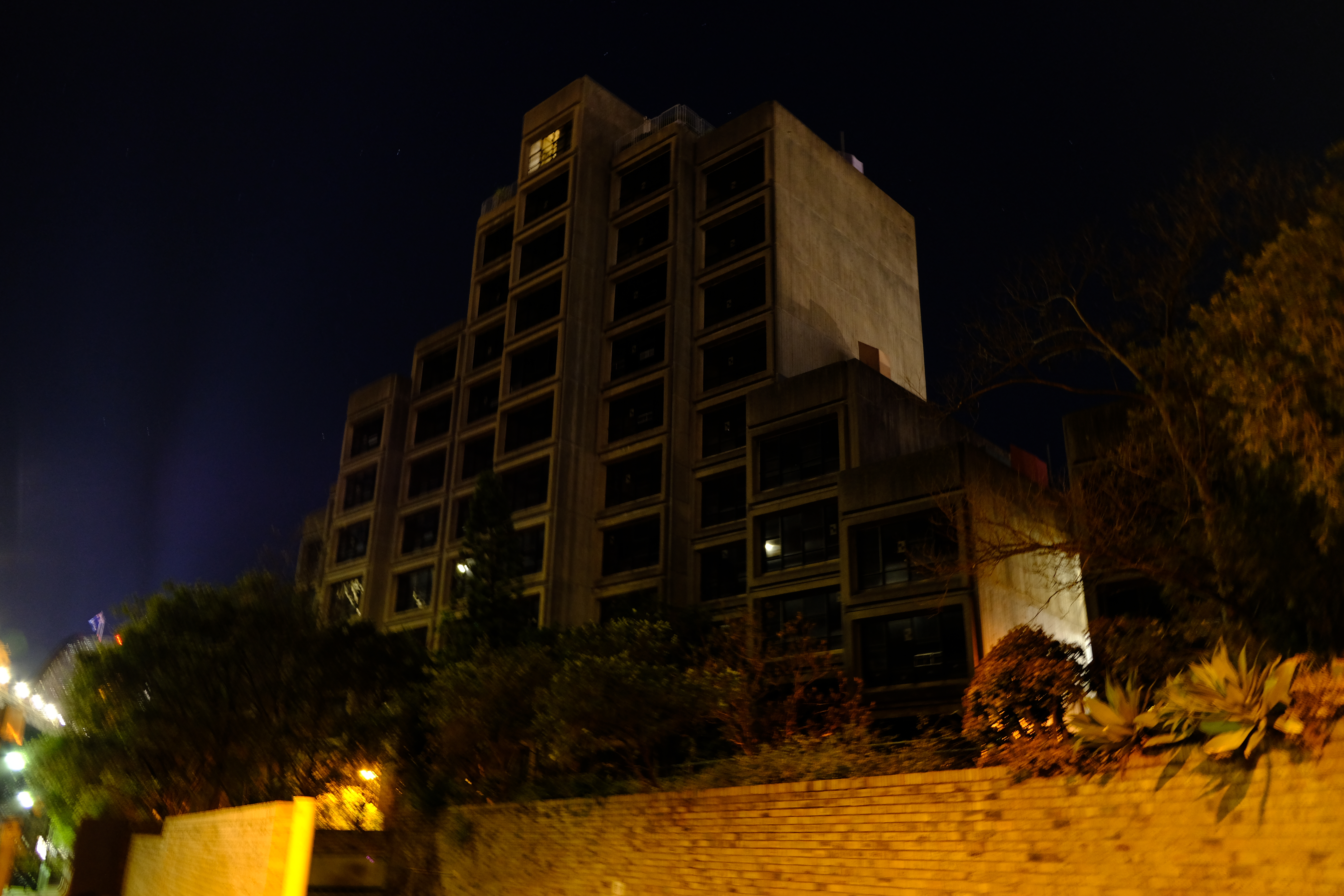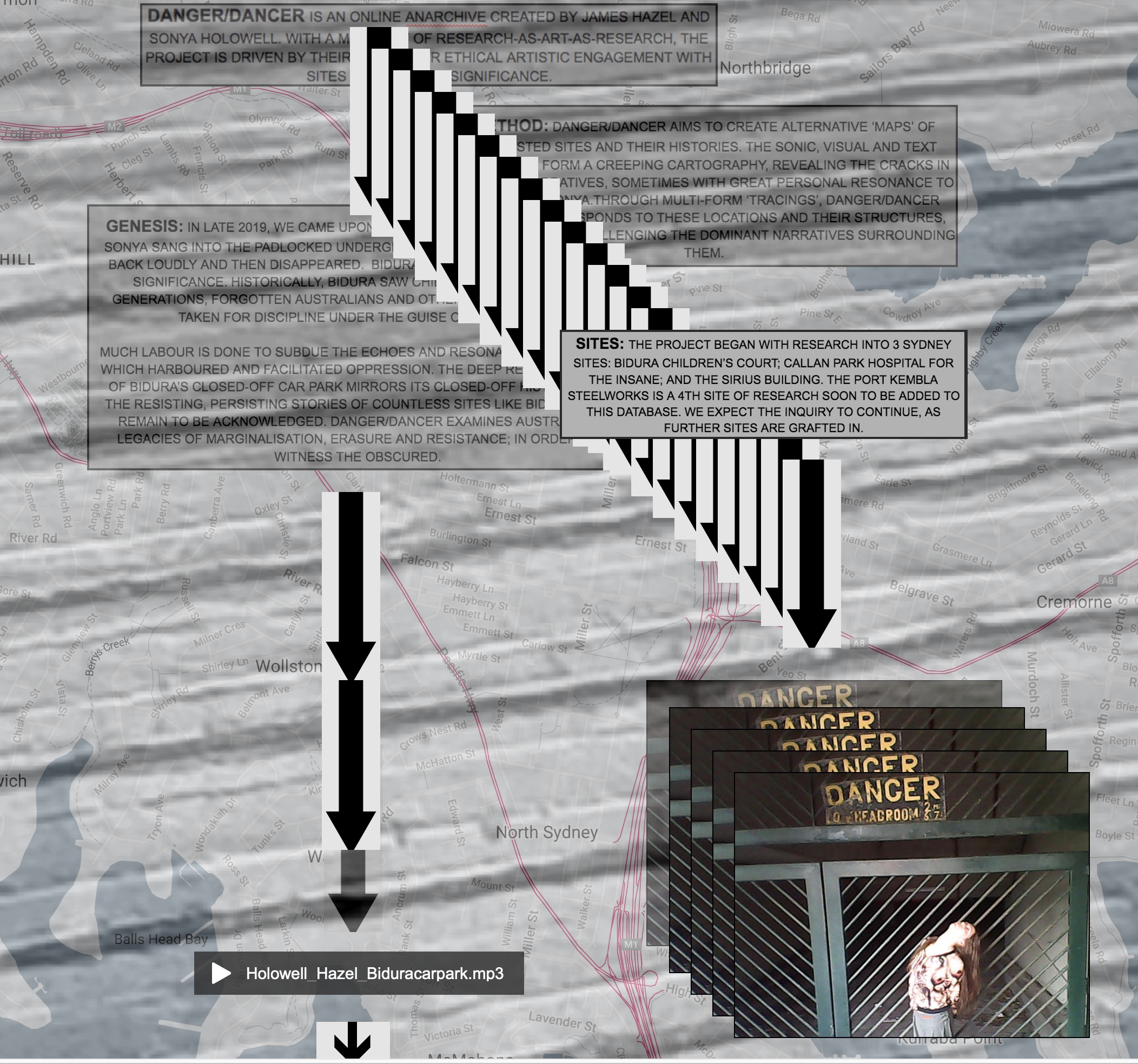DANGER/DANCER (2020-present)
Led by two composers (James Hazel and Sonya Holowell), Danger/Dancer (dangerdancer.com) is a project that was developed during the early months of the COVID19 lockdown in Sydney. This project is concerned with constructing an online counter-archive of sound-based responses to the silenced histories associated with Sydney institutional past, which are now under threat from complete erasure due to gentrified over-development. the counter-archive is a conceptual space for practice-led innovation within the flux and uncertainty of crisis associated with late- stage Capitalism. As an incomplete and unstable repository [...] a space of impermanence and play (Kashmere, 2010), the anarchival process generates ways in which to create an ongoing event in an online space, while developing new modes of public engagement, and revealing what is possible if face-to-face performances are not pragmatic. From these perspectives, the proposed paper presentation will narrate the context of the broader Danger/Dancer project, as situated among other forms of 21st century, sound-based anarchives, followed by an exploration of the broader anarchival applications within virtualised, social geographies and communities.”
Below text is an excerpt from the following DANGER/DANCER interview entitled
"Dance partners in the desert of the Real" (Firstdraft Gallery)"Sonya Holowell:
Danger/Dancer originated with the discovery of the old Bidura Children’s Court building in Glebe. It kind of seized us, before we really knew about it or its history and significance. We did a bit of interacting with the building and documented it, and this led to a continuation of research into Bidura, and other Sydney-based sites of significance, particularly to marginalised communities. These often had fraught histories which were under threat of erasure; or maybe histories/truths which never actually had the chance to see the light of day. The sign above the entrance to Bidura’s carpark said ‘Danger’, but it kind of looked like ‘Dancer’ as well. This became a pertinent symbol of the work we both wanted to continue pursuing.James Hazel: When Sonya first improvised into the depths of the car park, we were both taken aback by the intensity of the reverberation which modulated and disrupted the ‘rational’ continuity of her voice. It was interesting how the project arose out of a chance encounter with the Bidura Children’s Court and Metropolitan Remand Centre – as well as a later reckoning of the ethics of engaging with sound practice in spaces with contested and troubling histories. This was significant for us as we didn’t want to just ‘abstractly’ improvise around a site under threat from being demolished and redeveloped. This gentrifying process (in tandem with a careless sonic activation) posed the risk of (re)muting sites that were deeply implicated in the histories of the Stolen Generations and Forgotten Australians. So, before making any work, we undertook prolonged research into historical sources which would inform much of our sonic engagement with the sites – a form of care-full listening with and through the archives. We also collaborated and consulted with Wiradjuri and Gumbainggir composer and musician Timothy Gray who had first-hand experience of the Metropolitan Remand Centre when he was younger. These two processes generated increased social and sonic ‘fidelity’ around what Bidura was – and how this might come to terms with the ways in which these spaces are culturally mapped, spoken about and socio-historically sounded."
Led by two composers (James Hazel and Sonya Holowell), Danger/Dancer (dangerdancer.com) is a project that was developed during the early months of the COVID19 lockdown in Sydney. This project is concerned with constructing an online counter-archive of sound-based responses to the silenced histories associated with Sydney institutional past, which are now under threat from complete erasure due to gentrified over-development. the counter-archive is a conceptual space for practice-led innovation within the flux and uncertainty of crisis associated with late- stage Capitalism. As an incomplete and unstable repository [...] a space of impermanence and play (Kashmere, 2010), the anarchival process generates ways in which to create an ongoing event in an online space, while developing new modes of public engagement, and revealing what is possible if face-to-face performances are not pragmatic. From these perspectives, the proposed paper presentation will narrate the context of the broader Danger/Dancer project, as situated among other forms of 21st century, sound-based anarchives, followed by an exploration of the broader anarchival applications within virtualised, social geographies and communities.”
Below text is an excerpt from the following DANGER/DANCER interview entitled
"Dance partners in the desert of the Real" (Firstdraft Gallery)"Sonya Holowell:
Danger/Dancer originated with the discovery of the old Bidura Children’s Court building in Glebe. It kind of seized us, before we really knew about it or its history and significance. We did a bit of interacting with the building and documented it, and this led to a continuation of research into Bidura, and other Sydney-based sites of significance, particularly to marginalised communities. These often had fraught histories which were under threat of erasure; or maybe histories/truths which never actually had the chance to see the light of day. The sign above the entrance to Bidura’s carpark said ‘Danger’, but it kind of looked like ‘Dancer’ as well. This became a pertinent symbol of the work we both wanted to continue pursuing.James Hazel: When Sonya first improvised into the depths of the car park, we were both taken aback by the intensity of the reverberation which modulated and disrupted the ‘rational’ continuity of her voice. It was interesting how the project arose out of a chance encounter with the Bidura Children’s Court and Metropolitan Remand Centre – as well as a later reckoning of the ethics of engaging with sound practice in spaces with contested and troubling histories. This was significant for us as we didn’t want to just ‘abstractly’ improvise around a site under threat from being demolished and redeveloped. This gentrifying process (in tandem with a careless sonic activation) posed the risk of (re)muting sites that were deeply implicated in the histories of the Stolen Generations and Forgotten Australians. So, before making any work, we undertook prolonged research into historical sources which would inform much of our sonic engagement with the sites – a form of care-full listening with and through the archives. We also collaborated and consulted with Wiradjuri and Gumbainggir composer and musician Timothy Gray who had first-hand experience of the Metropolitan Remand Centre when he was younger. These two processes generated increased social and sonic ‘fidelity’ around what Bidura was – and how this might come to terms with the ways in which these spaces are culturally mapped, spoken about and socio-historically sounded."



